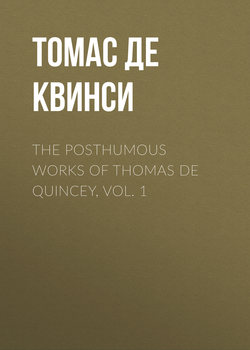Читать книгу The Posthumous Works of Thomas De Quincey, Vol. 1 - Томас Де Квинси - Страница 4
DE QUINCEY'S POSTHUMOUS WORKS
I. SUSPIRIA DE PROFUNDIS
SUSPIRIA DE PROFUNDIS
Оглавление1. Dreaming, †
2. The Affliction of Childhood. †
Dream Echoes. †
3. The English Mail Coach. †
(1) The Glory of Motion.
(2) Vision of Sudden Death.
(3) Dream-fugue.
4. The Palimpsest of the Human Brain. †
5. Vision of Life. †
6. Memorial Suspiria. †
7. Levana and our Ladies of Sorrow.
8. Solitude of Childhood. ☩
9. The Dark Interpreter. ☩
10. The Apparition of the Brocken. †
11. Savannah-la-Mar.
12. The Dreadful Infant. (There was the glory of innocence made perfect; there was the dreadful
beauty of infancy that had seen God.)
13. Foundering Ships.
14. The Archbishop and the Controller of Fire.
15. God that didst Promise.
16. Count the Leaves in Vallombrosa.
17. But if I submitted with Resignation, not the less I searched for the Unsearchable—sometimes
in Arab Deserts, sometimes in the Sea.
18. That ran before us in Malice.
19. Morning of Execution.
20. Daughter of Lebanon. †
21. Kyrie Eleison.
22. The Princess that lost a Single Seed of a Pomegranate. ☩
23. The Nursery in Arabian Deserts.
24. The Halcyon Calm and the Coffin.
25. Faces! Angels' Faces!
26. At that Word.
27. Oh, Apothanate! that hatest Death, and cleansest from the Pollution of Sorrow.
28. Who is this Woman that for some Months has followed me up and down? Her face I cannot
see, for she keeps for ever behind me.
29. Who is this Woman that beckoneth and warneth me from the Place where she is, and in
whose Eyes is Woeful remembrance? I guess who she is. ☩
30. Cagot and Cressida.
31. Lethe and Anapaula.
32. Oh, sweep away, Angel, with Angelic Scorn, the Dogs that come with Curious Eyes to gaze.
Thus of the thirty-two 'Suspiria' intended by the author, we have only nine that received his final corrections, and even with those now recovered, we have only about one half of the whole, presuming that those which are lost or remained unwritten would have averaged about the same length as those we have. To those who have studied the 'Suspiria' as published, how suggestive many of these titles will be! 'Count the Leaves in Vallombrosa'—what phantasies would that have conjured up! The lost, the apparently wasted of the leaves from the tree of human life, and the possibilities of use and redemption! De Quincey would there doubtless have given us under a form more or less fanciful or symbolical his reading of the problem:
'Why Nature out of fifty seeds
So often brings but one to bear.'
The case of the Cagots, the pariahs of the Pyrenees, as we know from references elsewhere, excited his curiosity, as did all of the pariah class, and much engaged his attention; and in the 'Cagot and Cressida' 'Suspiria' we should probably have had under symbols of mighty abstractions the vision of the pariah world, and the world of health and outward fortune which scorns and excludes the other, and partly, at all events, actively dooms it to a living death in England of to-day, as in India of the past, and in Jewry of old, where the leper was thrust outside the wall to wail 'Unclean! unclean!'
